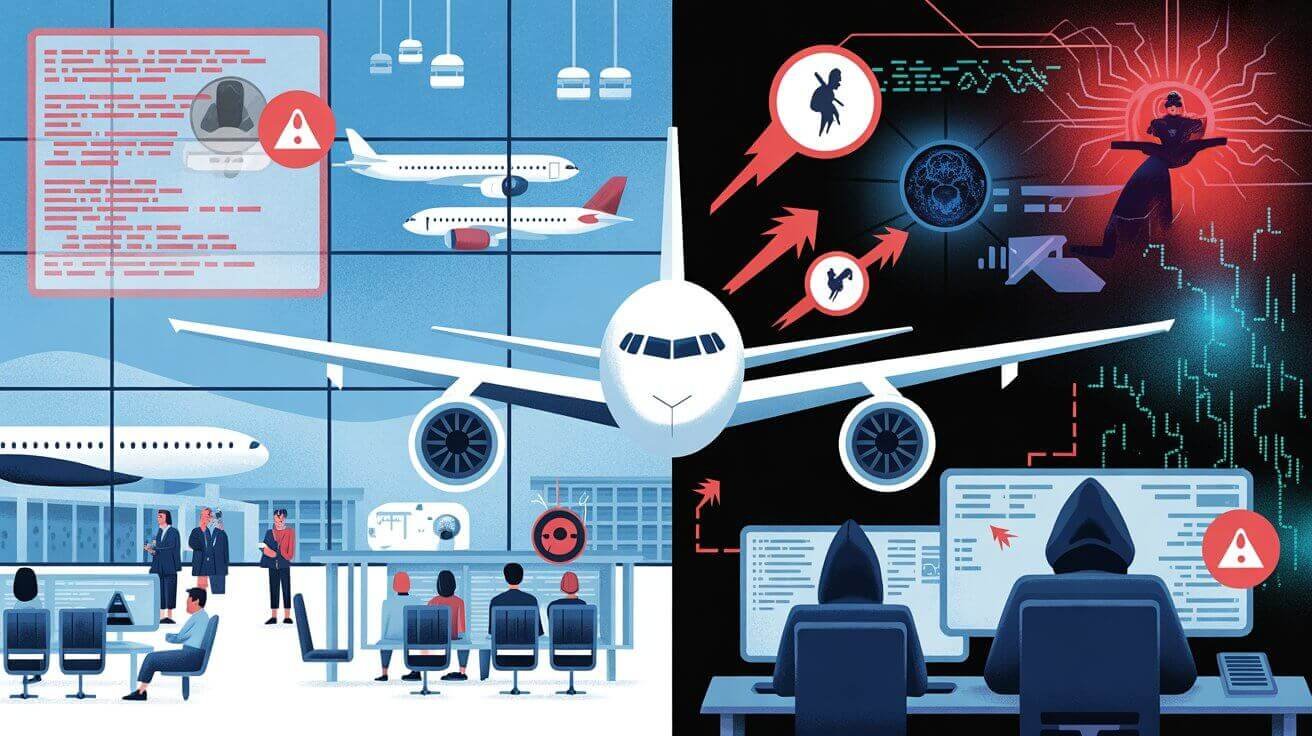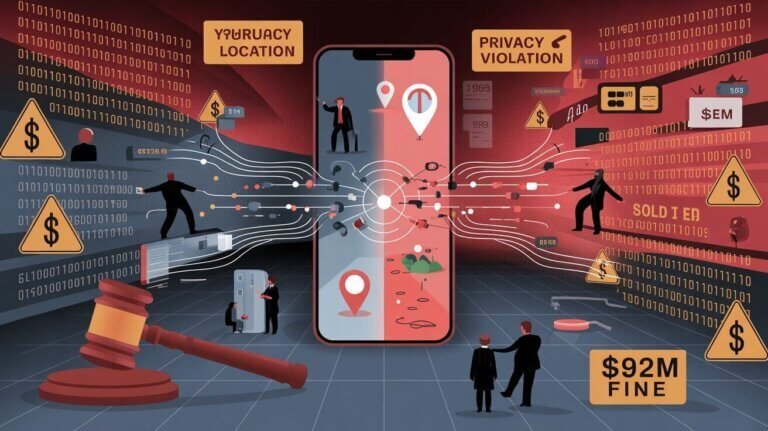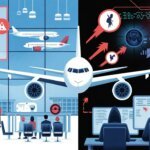The real story behind cyber attacks that are turning airports into chaos zones
Aviation cybersecurity threats are becoming the airline industry’s worst nightmare, and they’re affecting your travel more than you might realize. When aviation cybersecurity threats strike, they don’t just disrupt computer systems — they ground flights, strand passengers, and expose millions of travelers’ personal data to criminals.
Last month, I was supposed to catch a connecting flight through Seattle-Tacoma International Airport. What should have been a routine layover turned into an 8-hour nightmare when hackers shut down the airport’s systems. Baggage carousels stopped working. Flight information displays went blank. Even the wifi crashed.
That’s when I realized how vulnerable our entire air travel system really is.
The hack that changed everything
The Seattle airport attack wasn’t just some minor tech glitch. The Rhysida ransomware gang breached the Port of Seattle’s systems in August 2024, crippling ticketing, check-in kiosks, and passenger display boards. Over 90,000 people had their personal data stolen, including employees, contractors, and parking information.
But here’s what really scared me: this is happening everywhere.
German air traffic control got hit. Japan Airlines faced cyber attacks that disrupted luggage services during the busy New Year holiday. Los Angeles International Airport’s website went down completely when hackers flooded it with fake traffic.
And that’s just what made the news.
The numbers that’ll keep you up at night
The statistics around aviation cyber security are genuinely alarming. According to Help Net Security, cyber attacks on aviation jumped 131% between 2022 and 2023. We’re not talking about minor inconveniences — these are full-scale digital assaults.
Here’s what the cyber criminals are after:
- Flight management systems
- Air traffic control networks
- Passenger booking databases
- Baggage handling systems
- Aircraft navigation equipment
Thales reports that ransomware attacks alone jumped 600% in one year, with 27 major incidents from 22 different ransomware groups between January 2024 and April 2025.
That’s more than one major attack every two weeks.
The group targeting airlines right now
There’s a particularly nasty bunch of hackers called “Scattered Spider” who’ve made airlines their latest target. CNN reports that they’ve successfully breached multiple US and Canadian airlines just this year.
Their method is disturbingly simple. They call airline help desks pretending to be employees or customers, then trick staff into giving them access to internal systems. Once they’re in, they can steal customer data, disrupt operations, or hold entire systems hostage for ransom.
Hawaiian Airlines and WestJet both confirmed recent cyber attacks, though they haven’t named Scattered Spider specifically. But cybersecurity experts are seeing their fingerprints all over these incidents.
Why airports are sitting ducks
The problem isn’t just that hackers are getting smarter — it’s that airport infrastructure is incredibly vulnerable.
Most airports still run on legacy systems that were never designed with cybersecurity in mind. They’ve got aging equipment that lacks basic security features like regular security updates or compatibility with modern protection protocols.
Think about it: when you check in for a flight, your data goes through multiple systems. The airline’s booking platform. The airport’s display boards. TSA databases. Baggage tracking systems. Each one is a potential entry point for hackers.
And once cybercriminals get access to one system, they can often jump to others. It’s like dominoes falling.
The human factor that makes it worse
Here’s something that surprised me: most aviation cyber attacks succeed because of human error, not technical failures.
According to the Journal of Transportation Security, about 71% of attacks involve stealing login credentials or tricking employees into giving unauthorized access. Phishing emails have become particularly common, especially since COVID when more airport workers started working remotely.
Airport workers get fake emails that look legitimate. They click a malicious link or download an infected file. Suddenly, hackers have access to critical systems.
The scariest part? Many employees have no idea they’ve been compromised until it’s too late.
When flights actually get grounded
Let me tell you about some incidents that went way beyond just website outages.
In 2024, LOT Polish Airlines had to ground more than 10 flights when a DDoS attack prevented flight plans from being sent to aircraft. About 1,400 passengers were stranded at Warsaw airport.
Delta Air Lines faced a catastrophic IT outage when a faulty cybersecurity update crashed their systems. The result was over 7,000 canceled flights and 35,500 delays, affecting 1.3 million passengers and costing the airline $500 million.
These aren’t hypothetical risks. Real flights. Real passengers. Real chaos.
The new battleground: aircraft systems themselves
What really keeps aviation security experts awake at night isn’t just ground systems getting hacked — it’s the possibility of cyber criminals targeting aircraft while they’re in flight.
Modern planes are essentially flying computers. They send constant data streams about location, maintenance alerts, and navigation information. Every time this data gets transmitted, it’s vulnerable to interception.
The FAA is so concerned about this that they’ve proposed new rules requiring airplane manufacturers to protect against “intentional unauthorized electronic interactions” that could create safety hazards.
GPS spoofing is already happening, where hackers send false location signals to aircraft navigation systems. If someone could compromise flight management systems or communication networks, the safety implications are terrifying.
What regulators are finally doing about it
The good news is that aviation authorities are taking aviation cybersecurity threats seriously now.
The FAA introduced new cybersecurity regulations in August 2023, mandating that airplane manufacturers implement stringent measures against hacking. The European Union’s aviation safety agency has similar rules taking effect in 2026.
The Transportation Security Administration now requires airports to segment their networks, separating critical systems from general IT infrastructure. It’s like having multiple locked doors instead of one big open hallway.
But here’s the reality: regulations take years to implement fully, and hackers adapt faster than bureaucracy moves.
The money trail behind the attacks
Why are cybercriminals so interested in aviation? Follow the money.
According to SecurityScorecard research, about 65% of attacks target airports while 35% hit airlines directly. The aviation sector contributes $1.9 trillion in economic activity and supports 11 million US jobs, making it an incredibly lucrative target.
Airlines and airports often pay ransoms because downtime costs are enormous. One hour of operations disruption at a large airport during peak time costs an estimated $1 million.
Cybercriminals know this. They’re not just random hackers anymore — they’re organized business operations with profit motives.
What travelers can actually do
I know this all sounds pretty doom and gloom, but there are things you can do to protect yourself when flying.
Before you travel:
- Never use public USB chargers at airports (they can install malware while charging your device)
- Avoid connecting to public wifi for sensitive activities like banking
- Keep important travel documents backed up separately from your phone
At the airport:
- Don’t plug in random USB drives you might find (hackers leave infected drives hoping people will plug them in)
- Be suspicious of unexpected emails or texts about flight changes
- Use your phone’s hotspot instead of airport wifi when possible
Watch for warning signs:
- Flight information displays showing errors or unusual messages
- Check-in kiosks that seem slow or unresponsive
- Airport staff asking for unusual information or verification
The future of flying in a cyber world
Aviation cybersecurity is going to get more complex, not simpler. As planes become more connected and airports get smarter, the attack surface for cybercriminals grows.
IBM’s research shows that 55% of aviation cyber security decision-makers admit their organizations have been hit by ransomware in the past year. Among those, 38% reported operational disruption and 41% lost data.
The industry is investing in AI-driven threat detection, blockchain for secure data transactions, and zero-trust network architectures. But technology solutions are only part of the answer.
The human side of airline security
What impressed me most in my research was learning how much airline security depends on people, not just technology.
Employee training has become paramount. Airlines are teaching staff to recognize phishing attempts and social engineering tactics. Some are conducting regular cybersecurity drills, like fire drills but for hackers.
Because at the end of the day, the most sophisticated security system in the world can be defeated by one employee clicking the wrong link.
The bottom line for travelers
Aviation cybersecurity threats aren’t going away. If anything, they’re getting worse as our air travel system becomes more digitized and connected.
But that doesn’t mean you should stop flying. It means you should fly smarter.
Airlines and airports are investing billions in cybersecurity improvements. New regulations are forcing better protections. The industry is finally taking these threats as seriously as they deserve.
Your next flight probably won’t be grounded by hackers. But if it is, now you’ll understand why — and you’ll know it’s not just a simple “technical difficulty.”
The sky might be friendly, but the cyber criminals trying to hack it definitely aren’t.
Stay safe up there.








